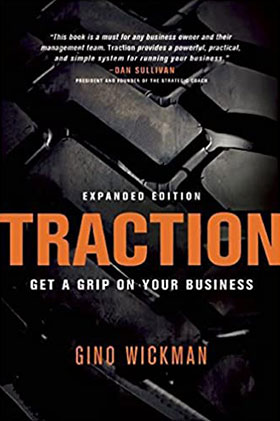In his book Traction: Get a Grip on Your Business, Gino Wickman provides an operating system for businesses seeking consistency in quality, growth, and processes from the outset. Wickman provides a series of scenarios in which startups could benefit from leveraging the Traction methodology. Whether you’re dealing with an unprofitable business, a business that is simply reacting to the market, stalling growth, or poor team performance, this book provides a series of tools and templates for effectively running a business.
Book Specifications
Title: Traction: Get a Grip on Your Business
Author: Gino Wickman
Formats: Hardcover, Paperback, MP3 CD, Audible, and Kindle
Publisher: BenBella Books
Published: April 3, 2012
Pages: 246
ISBN-10: 1936661837
ISBN-13: 978-1936661831
Aligning on a Vision
Among the tools Wickman introduces is the Visual Traction Organizer (VTO). Without getting into the details of how to build your own VTO, I’ll just say that this tool is similar to other business-organization tools—especially Strategyzer’s Business Model Canvas. The VTO helps focus the business on core concepts—the first among them being values. When an organization knows its values, it is much easier to identify the right people, the right products, and the right customers. Simply put, if the values of a team member are out of step with those of the firm, there will be tension, conflict, and probably poor performance all around.
Similarly, the VTO helps a firm focus on its core value proposition—the kind of business it should pursue. The book’s general advice is to choose a small number of things that you do better than anyone else, then focus on executing against that capability. Companies can find themselves getting into trouble when they expand their business scope without a solid rationale—something other than growth. More often than not, especially for small businesses, expanding their scope distracts them from their core value, and the entire business suffers. In general, companies would actually do better to focus on execution.
An example of this issue might be a commercial construction firm’s deciding to get into residential leasing. While it might be true that the firm has experience building multitenant homes, building and managing them are not the same thing. They would need to develop new capabilities such as marketing to a new audience, developing building and grounds maintenance, and managing utilities and renters. Even though the prospect of low-effort, recurring revenue is attractive, it is important that such a firm not simply chase revenue because they can. This is not to say that a developer could not or should not also manage buildings—many have. But any expansion into a new business or market must be in alignment with the organization’s vision.
 Over the past several years, I’ve been spending more of my time working with startups, entrepreneurs, and solopreneurs. Many founders have a lot of passion for their ideas and fervently believe they can build a successful company. There are also many programs available to help businesses start up, through grants and matching funds. Plus, there is a plethora of books, Web sites, and other information available to help founders go through the mechanics of establishing a business and filing the right paperwork.
Over the past several years, I’ve been spending more of my time working with startups, entrepreneurs, and solopreneurs. Many founders have a lot of passion for their ideas and fervently believe they can build a successful company. There are also many programs available to help businesses start up, through grants and matching funds. Plus, there is a plethora of books, Web sites, and other information available to help founders go through the mechanics of establishing a business and filing the right paperwork.